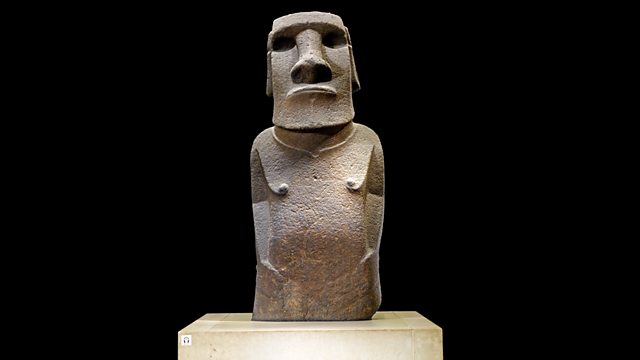Hoa Hakananai'a Easter Island statue
This week Neil MacGregor is with the gods between AD 1200 -1500. Today he tells the story of one of the astonishing giant sculpted figures from Easter Island.
This week Neil MacGregor is exploring the sophisticated ways in which people connected to gods and ancestors in the Middle Ages. He is looking at religious images from India, France, Mexico and Turkey.
Today - in the last programme of the second series - he is with one of the most instantly recognisable sculptures in the world: one of the giant stone heads that were made on Easter Island in the South Eastern Pacific Ocean. These deeply mysterious objects lead Neil to consider why they were made and why many were ultimately thrown down.
What was the Easter Islanders understanding of their gods and their ancestors? Steve Hooper, an expert on the arts of the Pacific, and the internationally renowned sculptor Sir Anthony Caro both respond to this monumental work of devotion.
Producer: Anthony Denselow
Last on
More episodes
Next
You are at the last episode
![]()
Discover more programmes from A History of the World in 100 Objects about religion
About this object
Location: Easter Island (Rapa Nui)
Culture: Aztec, Maya and Central America
Period: AD 1000
Material: Stone
��
This statue known as a moai comes from the Island of Rapa Nui, also known as Easter Island. Rapa Nui in the Pacific Ocean is one of the most remote inhabited islands in the world. Polynesians first settled on it before AD 800. Around 1000 moai were carved, probably to commemorate important former chiefs who were revered as divine. By 1600 the islanders ceased to make moai and they began to topple and even bury some of them.
Why did the Rapanui stop making moai?
Rapa Nui was deforested during the centuries people lived there and much of its birdlife became extinct. A birdman cult emerged that replaced the worship of moai. Birdman motifs can be seen on the back of this statue. The central ritual of this religion saw chiefs compete to capture the first sooty tern egg of the season. The triumphant chief would then become the birdman. Representing the creator god, he would live for one year in isolation, shaving his hair and growing his nails like talons.
Did you know?
- Hoa Hakananai'a means 'stolen or hidden friend'.
An ambassador for all time
By Cristian Arevalo Pakarati, Easter Island
��
Long ago, as a child of eight, I started to help my father by carrying surveying equipment to map certain places on the north and western side of the island. This was my first experience of the archaeological heritage of Easter Island.
My work in recent years has mainly been systematically locating, drawing and measuring all of the Easter Island statues, in the context of the island, and in museum collections. I have made a total of more than 4,000 drawings for the Easter Island Statue Project, directed and created by Dr. Jo Anne Van Tilburg in the 1980s.
Being in touch with the statues for so many years in so many places and seeing them from many sights, perspectives and views - some standing and some knocked down from their ancestral pedestals, decapitated and abandoned - I am still in search of my own past, a walk that will never have an end, because every single statue in context or out there in the world is unique, there aren’t two of them alike. They are all individuals with different features that match the feelings of different eras in order to meet the needs of a group of people. People who wanted their effort to be represented in things, to respect and recall the old, their ancestors – from the men who brought the biggest fish from the deepest blue, to the men who brought the sweetest potatoes from the highest hills, which underlined the importance of living in balance with nature.
Our ‘hidden friend’, the moai Hoa Hakananai'a is all that, and accomplishes the idea of showing changes – the old, the present, and the future. He could easily belong to any era. He was re-carved with new symbols on his back to match the requirement of a specific new situation – the coming of new ideas and beliefs with changes of politics and religion. Maybe that was his real message – to last.
I would be not be afraid to say that Hoa Hakananai'a is the perfect representation of those changes, and the ability of humans to adapt in order to survive.
The best ambassador for Easter Island - the one who is really going to last and to transcend all time.
Transcript
Broadcasts
- Fri 9 Jul 2010 09:45�������� Radio 4 FM
- Fri 9 Jul 2010 19:45�������� Radio 4
- Sat 10 Jul 2010 00:30�������� Radio 4
- Fri 16 Jul 2021 13:45�������� Radio 4
Featured in...
![]()
Religion—A History of the World in 100 Objects
A History of the World in 100 Objects - objects related to religion.
Podcast
-
![]()
A History of the World in 100 Objects
Director of the British Museum, Neil MacGregor, retells humanity's history through objects





